Toyota Corolla (E120): Inspection
1. Intake air flow meter sub–assy

- Inspect the intake air flow meter resistance.
- Using an ohmmeter, measure the resistance between terminals tha and e2.
Resistance:
at –20 c (–4 f) 13.6 To 18.4 KΩ
at 20 c (68 f) 2.21 To 2.69 KΩ
at 60 c (140 f) 0.49 To 0.67 KΩ
Hint
: if the resistance is not as specified, replace the intake air flow meter.
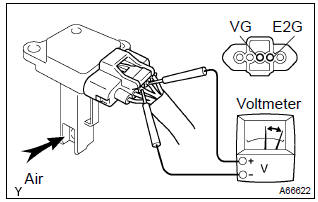
- Inspect the intake air flow meter operation.
- Connect the intake air flow meter connector.
- Turn the ignition switch to on.
- Using a voltmeter, connect the positive (+) tester probe to terminal vg, and negative (–) tester probe to terminal e2g.
- Blow air into the intake air flow meter, and check that
the voltage fluctuates.
Hint
: if operation is not as specified, replace the intake air flow meter.
- Turn the ignition switch to lock.
- Disconnect the intake air flow meter connector.
2. Camshaft timing oil control valve assy
- resistance inspection.
- Using an ohmmeter, measure the resistance between
the terminals.
Resistance: 6.9 To 7.9 W at 20 c (68 f)
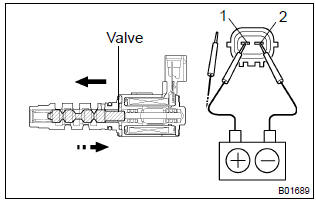
- Movement inspection.
- Connect the positive (+) lead from the battery to terminal 1 and negative (–) lead to terminal 2, and check the movement of the valve.
Notice
: confirm the valve does not adhere.
Hint
: bad returning of the valve by entrance of foreign objects causes subtle pressure leak to the advanced direction. Then, dtc can be detected.
3. Throttle body assy
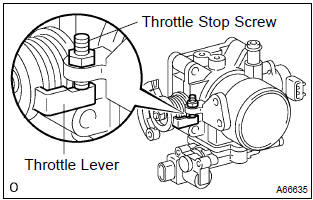
- Check throttle body.
- Check that throttle valve shaft is not rickety.
- Check that each port is not stopped up.
- Check that throttle valve opens and closes smoothly.
- Check that there is no clearance between the throttle stop screw and throttle lever at the throttle closed position.
Notice
: do not adjust the throttle stop screw.
4. E.F.I. Throttle position sensor
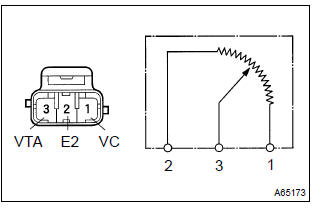
- Resistance inspection.
- Disconnect the throttle position sensor connector.
- Using an ohmmeter, measure the resistance between
terminals vc and e2.
Resistance: 2.5 To 6.0 KΩ
- check the change of resistance between terminals vta and e2.
Change of resistance: the resistance value increases in proportion to the throttle lever opening value.
Hint:

5. E.F.I. Engine coolant temperature sensor
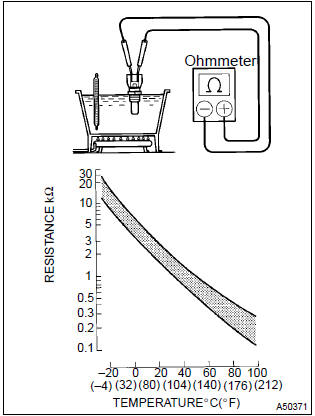
- Resistance inspection.
- Using an ohmmeter, measure the resistance between each terminal.
Resistance:
at 20 c (68 f) 2.32 – 2.59 KΩ
at 80 c (176 f) 0.310 – 0.326 KΩ
Notice
: in case of checking the water temperature sensor in the water, be careful not to allow water to go into the terminals, and after checking, wipe out the sensor.
6. Knock control sensor
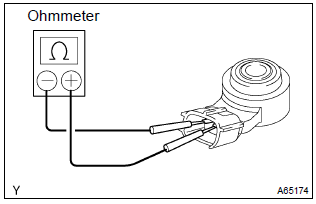
- Using an ohmmeter, measure the resistance between terminals.
Resistance: 120 – 280 kΩ at 20 c (68 f)
Hint
: if the resistance is not specified, replace the sensor.
7. E.F.I. Circuit opening relay assy
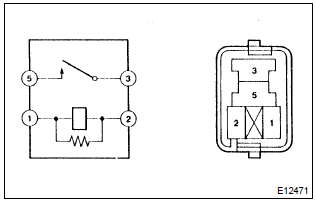
- Continuity inspection.
- Using an ohmmeter, check that continuity exists between
each terminal.
Specified condition:
between terminals 1 and 2 continuity between terminals 3 and 5 no continuity - using an ohmmeter, check that continuity exists between terminals 3 and 5 when the battery voltage is applied across terminals 1 and 2.
8. E.F.I ecu relay
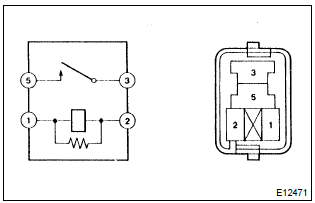
- Continuity inspection.
- Using an ohmmeter, check that continuity exists between
each terminal.
Specified condition:
between terminals 1 and 2 continuity between terminals 3 and 5 no continuity - using an ohmmeter, check that continuity exists between terminals 3 and 5 when the battery voltage is applied across terminals 1 and 2.
Other materials:
Inspection procedure
1 Check side squib(lh) circuit(airbag sensor assy center – front
seat airbag assy lh)
Disconnect the negative (–) terminal cable from the battery,
and wait at least for 90 seconds.
disconnect the connectors between the airbag sensor
assy center and the front seat airbag assy ...
Cd cannot be inserted or is ejected right after
insertion
Wiring diagram
Inspection procedure
1 Check if a proper cd is inserted
Check that a proper cd is inserted.
Make sure that the cd is normal audio cd, and that there is no
deformation, flaw, stain, burr and
other defects on the cd.
Standard: normal audio cd.
Reference:
...
Foamed material application areas
If an increase in temperature or other condition damages the foamed material
when repairing or replacing the panel,
fill in the insufficient areas with urethane foam. The following illustration
shows the areas for one side, but the
foamed material must be applied equally to both the left and r ...


